
Back to school: did the supermarkets make the grade?
Uniform? Tick. Stationery? Tick. Packed lunch? Tick.
Name tags sewn into clothes? Arggghhhhh! That’s right, SCHOOL IS BACK! And millions of parents across the UK have spent the past few weeks (or days!) frantically rushing around to ensure their little angels are all set for the new school year.
So, we found it an interesting exercise to examine how ecommerce brands in the supermarket industry have used content in vastly different ways to promote their ranges and products – from uniform and food, to stationery and more - at this notoriously busy time.
Unless you’ve been asleep under a rock for the past few years, it’s clear that the relationship between e-commerce and content is more important than ever before and a vital component of a brand’s ecommerce strategy.
Content can range from product page copy, helping customers move seamlessly through the site, and micro-copy, that can help them complete a transaction, to more relationship-building focused content - which aims to attract customers and build and gain the trust of an audience.
Gary Specter, VP sales and customer success at Magento, told an audience at a recent event in Dubai that: “Brands today are built on end-to-end experiences. Beautifully curated content with Amazon efficiency is the Holy Grail.”
But while many ecommerce brands are fully embracing the need for regular, relevant content as part of their ecommerce strategy, many others are merely paying lip service to using content - or failing to maximise its full potential.
Supermarkets slow to adopt ecommerce revolution?
It’s long been held that the supermarket industry has been among the slowest major retail sectors to fully embrace the ecommerce revolution. In fact, a grocery research panel during March’s ShopTalk conference in Las Vegas said the industry’s ecommerce tipping point wouldn’t arrive until 2025 - with the tipping point relating to the time when digital commerce accounts for 20 per cent of all sales.
To put this into context, the book industry was said to have reached its tipping point in 2005 – thanks largely to Amazon - with electrics following suit around 2008 and clothing reaching it later this year. But the panel’s research found that grocery retailers lagged far behind, believing they were not spending enough time on content strategies and in particular, in integrating recipes properly onto their sites.
And as millions of pupils either started school for the first time, or returned after the summer holidays this week, a scan of the UK’s major supermarket sites backed up this view.
An Adobe blog on back to school shopping featured a seldom quoted statistic from Fox Business that had the back-to-school season representing 17 per cent of total retail sales last year, coming in second only to the Christmas holiday season.
So, which supermarkets have mastered their content strategy?
Yet the Morrisons supermarket site had nothing about ‘back to school’ on its home page at all - although its site did have a section for the student new term, featuring lists of products university students might need such as kettles, that could be put straight into the basket for delivery.
Sainsbury’s had nothing on its homepage about ‘back to school’ either, although clicking on the groceries category in the main navigation menu did present an option of a ‘school shop’, featuring lists of items from stationery and school uniform to purchase.
Asda’s site also had nothing school-based on its home page, although clicking on the groceries category in the main navigation bar and scrolling down allowed customers to also find a section called the ‘school shop’. This took them to a new page of similar products to that of Sainsbury’s, PLUS the bonus of individual food items that children might take to school for their packed lunch, such as packaged segments of fruit.
However, Aldi made the most of the ‘back to school’ season, promoting its range in the main slider on its homepage - showing the importance the brand placed on having relevant content to help drive sales in this area.
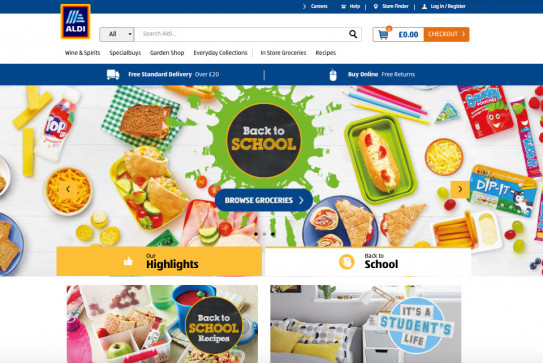
Furthermore, Aldi also put together another section on back to school recipes. Through this, the customer could browse dozens of recipes from dinners to packed lunches – a helpful service for mums and dads stuck for ideas of what to send in with their kids, or cook when they got home with limited time on their hands. This is a great way for a brand to connect with its customers and encourage them to check in on the site regularly as well as give ample opportunities to tie-in and promote different food brands.
Unfortunately, as Aldi only runs a partial online delivery service, shoppers are unable to put the recipe items straight into their shopping basket and make the most of this excellent content – needing to write the recipes out and find their nearest store to buy the products instead.
Aldi featured some relevant recipes - but customers are unable to make use of this due to its partial delivery service
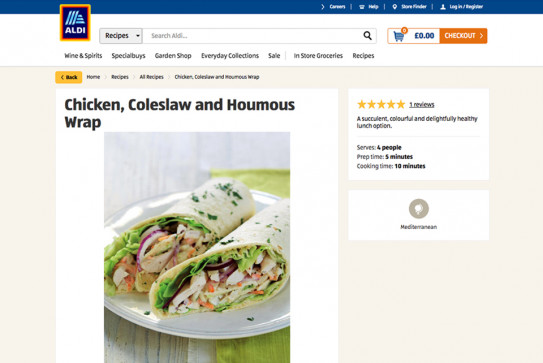
But in our opinion, this is where Tesco excels, leading the way in how to use relevant content while proving ‘Back to School’ content doesn’t need to solely focus on uniform and stationery.
Firstly, its site featured a Kids Lunchbox recipes section on its home page, giving busy parents a range of recipes that they could scroll through, with innovative and healthy packed lunch ideas. Content included good clear photos of what these will look like once prepared and how many calories each portion contained – a massive bonus in these days of healthy eating and a surefire way to encourage parents to return for further creative recipe ideas.
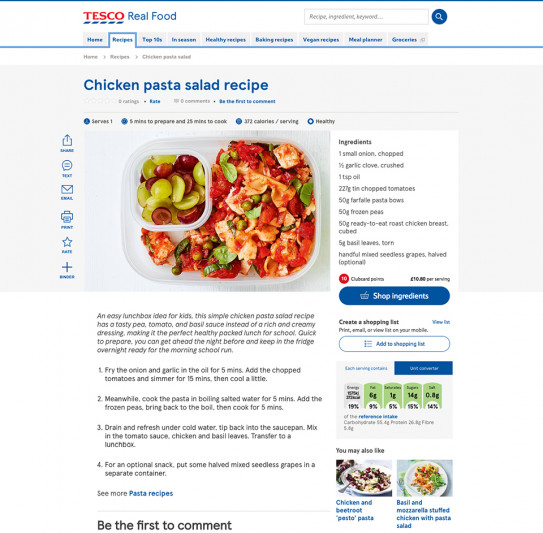
However, Tesco went further still, featuring another excellent section on its homepage, incorporating a back to school meal plan.
Click through and parents were able to plan their week’s meals in advance – giving them ideas of what to cook and the choice of putting all the ingredients straight in the basket ready for delivery and saving time for those poor souls doing the food shop. Brilliant!
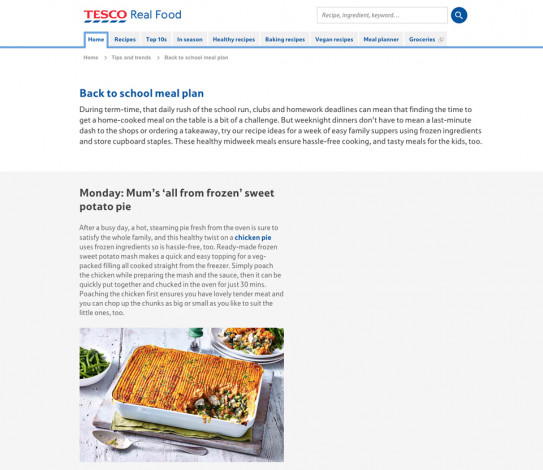
But for those on a tight budget, this approach to content would also provide another valued service to customers in helping them save money through cutting down on food waste, allowing them to buy exactly what they need for each meal for a whole week or more.
As Bill Gates once said “Content is King”
Adobe’s recent acquisition of Magento reinforces the opinion that content will continue to play a major role in the future of ecommerce. Content has always been a key component of Adobe’s strategy and this combined force, along with partners like Redbox Digital, will help provide the seamless digital experience across channels and devices that Gary Specter alluded to.
However, while other industries strive for omi channel retailing - a fully-integrated approach to commerce across online and offline channels – the grocery industry still has much work to do to catch up.
Despite regularly updated recipes being looked upon as a key area to attract customers in the supermarket industry, it’s interesting to note how few give these sections prominence on their homepages.
Meanwhile, some 73 per cent of consumers are more likely to purchase a product or service if they watch a video beforehand, according to recent figures compiled by Animoto. Yet videos of people or chefs preparing dishes - or of anything at all - are sadly lacking on the supermarket sites.
Brands in the clothing industry are miles ahead in terms of using video content to engage with customers.
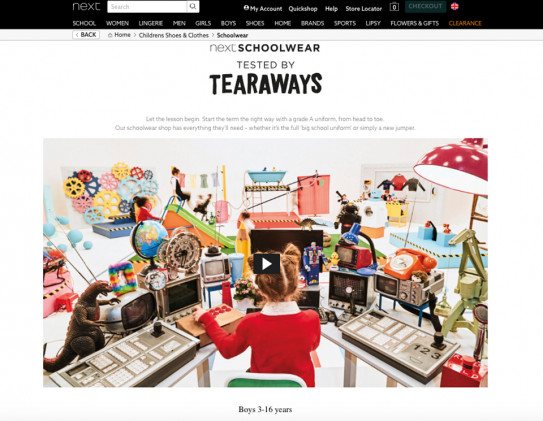
Next, for instance, has a superbly-made, fun video for its back to school range on its homepage - with kids testing out their waterproof coats and getting their clothes covered in paint. Expect to see more video content from the supermarket brands as they catch up with other industries over the next few years.
In summary, despite the ‘back to school’ season coming second only to the Christmas season in terms of sales, many supermarkets were sadly lacking any relevant, engaging content to reflect or promote that fact.
For the supermarkets with uniforms and clothing, fun videos that most clothing brands are using to full effect, are still missing.
Despite parents of school children looking for inspiration for lunches and dinners, most bypassed the season or spent the bare minimum of time in engaging with its customers about it.
But Tesco showed how it could be done. Not only did the brand spend time on colourful, engaging content featuring fun recipe ideas as part of its ecommerce strategy, it also included meal plans to entice and support its customers. Both were featured clearly on their homepage in a prominent position for full effect.